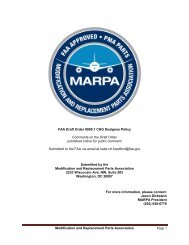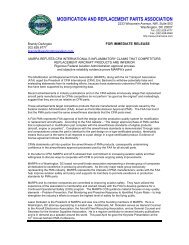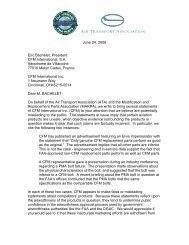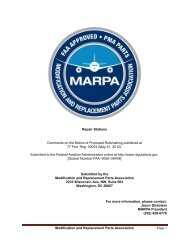Policy Statement, PS-AIR-21.50-01: Inappropriate DAH ... - MARPA
Policy Statement, PS-AIR-21.50-01: Inappropriate DAH ... - MARPA
Policy Statement, PS-AIR-21.50-01: Inappropriate DAH ... - MARPA
You also want an ePaper? Increase the reach of your titles
YUMPU automatically turns print PDFs into web optimized ePapers that Google loves.
<strong>Policy</strong> <strong>Statement</strong>, <strong>PS</strong>-<strong>AIR</strong>-<strong>21.50</strong>-<strong>01</strong>: <strong>Inappropriate</strong> <strong>DAH</strong><br />
Restrictions on the Use and Availability of ICA<br />
Comments on the Draft <strong>Policy</strong> <strong>Statement</strong><br />
Announced at 76 Fed. Reg. 61999 (October 6, 2<strong>01</strong>1)<br />
And published online for public comment<br />
Submitted to the FAA via email at john.cerra@faa.gov<br />
and via the comment function at regulations.gov<br />
Docket ID: FAA-2<strong>01</strong>1-1097<br />
Submitted by the<br />
Modification and Replacement Parts Association<br />
2233 Wisconsin Ave, NW, Suite 503<br />
Washington, DC 20007<br />
For more information, please contact:<br />
Jason Dickstein<br />
<strong>MARPA</strong> President<br />
(202) 628-6777
MODIFICATION AND REPLACEMENT PARTS ASSOCIATION<br />
2233 Wisconsin Avenue, NW, Suite 503<br />
Washington, DC 20007<br />
Tel: (202) 628-6777<br />
Fax: (202) 628-8948<br />
http://www.pmamarpa.com<br />
<strong>Policy</strong> <strong>Statement</strong>, <strong>PS</strong>-<strong>AIR</strong>-<strong>21.50</strong>-<strong>01</strong>: <strong>Inappropriate</strong> <strong>DAH</strong><br />
Restrictions on the Use and Availability of ICA<br />
Comments submitted to the FAA via email at john.cerra@faa.gov<br />
and via the comment function at regulations.gov, Docket ID: FAA-2<strong>01</strong>1-1097<br />
December 5, 2<strong>01</strong>1<br />
John Cerra, <strong>AIR</strong>-110<br />
Federal Aviation Administration<br />
Mike Monroney Aeronautical Center<br />
6500 S. MacArthur Blvd.<br />
ARB--Room 308<br />
Oklahoma City, OK 73169<br />
Dear Mr. Cerra:<br />
The Modification and Replacement Parts Association would like to commend the<br />
FAA for its work in developing and drafting this <strong>Policy</strong>. Our specific comments follow.<br />
Contents<br />
What is <strong>MARPA</strong>? ........................................................................................................................... 2<br />
Comments ....................................................................................................................................... 2<br />
History and Background ............................................................................................................. 3<br />
Intellectual Property and Recent Court Decisions ...................................................................... 4<br />
The FAA <strong>Policy</strong> .......................................................................................................................... 5<br />
<strong>MARPA</strong> Supports the FAA <strong>Policy</strong> ............................................................................................. 6<br />
Conclusion ...................................................................................................................................... 7<br />
Modification and Replacement Parts Association Page 1
What is <strong>MARPA</strong>?<br />
The Modification and Replacement Parts Association was founded to support<br />
PMA manufacturers and their customers. Aircraft parts are a vital sector of the aviation<br />
industry, and <strong>MARPA</strong> acts to represent the interests of the manufacturers of this vital<br />
resource before the FAA and other government agencies.<br />
<strong>MARPA</strong> is a Washington, D.C.-based, non-profit association that supports its<br />
members’ business efforts by promoting excellence in production standards for PMA<br />
parts. The Association represents its members before aviation policy makers, giving<br />
them a voice in Washington D.C. to prevent unnecessary or unfair regulatory burden<br />
while at the same time working with aviation authorities to help improve the aviation<br />
industry’s already-impressive safety record.<br />
<strong>MARPA</strong> represents a diverse group of manufacturing interests – from the<br />
smallest companies to the largest - all dedicated to excellence in producing aircraft<br />
parts.<br />
<strong>MARPA</strong> members are committed to supporting airlines with safe aircraft<br />
components. <strong>MARPA</strong> members manufacture and sell aircraft components that provide<br />
equal or better levels of reliability when compared to their original equipment<br />
manufacturer competitors.<br />
<strong>MARPA</strong> supports efforts to produce guidance that increase safety. <strong>MARPA</strong><br />
applauds the FAA’s efforts to establish fair and reasonable guidelines for reasonable<br />
ICA distribution methods.<br />
Comments<br />
The Modification and Replacement Parts Association would like to commend the<br />
FAA for its work in developing and drafting this <strong>Policy</strong>. This <strong>Policy</strong> appears to begin<br />
addressing some of the issues that have threatened to undermine safety by<br />
promulgating a reasonable interpretation of existing regulations that is consistent with<br />
the Administration's stated goals at the time those regulations we promulgated.<br />
The industry has been discussing some of the problems with the ICA system for<br />
at least twenty years. Many of these issues relate to companies that misuse the<br />
practical monopolies associated with the ICA system to obtain unintended competitive<br />
advantage.<br />
While the Draft <strong>Policy</strong> does not solve all of the issues, the Association believes<br />
that this <strong>Policy</strong> takes an important first step to restoring some reasonableness to the<br />
ICA system.<br />
Modification and Replacement Parts Association Page 2
History and Background<br />
The industry has always relied on product-level maintenance manuals published<br />
by the manufacturers of the products. These manuals were intended to provide certain<br />
baseline procedures for accomplishing maintenance and the maintenance industry<br />
relied on them for the purpose of accomplishing maintenance. 1<br />
In 1980, the FAA recognized that some product manufacturers were not<br />
publishing adequate manuals. 2 In response, the FAA published three sets of important<br />
regulations.<br />
First, in each of the airworthiness standards, the FAA published a requirement to<br />
3<br />
publish Instructions for Continued Airworthiness (ICAs).<br />
Second, in each of the airworthiness standards, the FAA published appendices<br />
that explained what must be included (at a minimum), in these ICAs. 4 These<br />
appendices also permitted the product manufacturers to rely on component<br />
maintenance manuals by incorporating them by reference. 5 These appendices also<br />
required the product manufacturers to have a method for distributing the ICAs (and any<br />
amendments). 6 The method for distributing the ICAs must be acceptable to the<br />
Administrator. 7<br />
1 See Airworthiness Review Program—Amendment No. 8A: Aircraft, Engine and Propeller Airworthiness, and<br />
Procedural Amendments, 45 FR 6<strong>01</strong>54 (Sept. 11, 1980) (finding recommended maintenance procedures made<br />
available under then-current regulations were frequently inadequate, and that lack of such recommended<br />
maintenance procedures could best be remedied by requiring they be made available to owners and operators.)<br />
2 Id.<br />
3 See, e.g., Airworthiness Standards: Normal, Utility, Acrobatic, and Commuter Category, Instructions for<br />
Continued Airworthiness, 14 C.F.R. § 23.1529 (as amended, Sept. 11, 1980) (“The applicant must prepare<br />
Instructions for Continued Airworthiness in accordance with appendix G to this part that are acceptable to the<br />
Administrator.”). See also 14 C.F.R. § 25. 1529 (Requiring instructions acceptable to administrator for transport<br />
category airplanes); 14 C.F.R. § 25.1729 (Requiring instructions acceptable to administrator for transport category<br />
airplanes with Electrical Wiring Interconnection Systems); 14 C.F.R. § 27.1527 (Requiring instructions acceptable<br />
to administrator for normal category rotorcraft); 14 C.F.R. § 29.1529 (Requiring instructions acceptable to<br />
administrator for transport category rotorcraft); 14 C.F.R. § 31.82 (Requiring instructions acceptable to<br />
administrator for manned free balloons); 14 C.F.R. § 33.4 (Requiring instructions acceptable to administrator for<br />
aircraft engines); 14 C.F.R. § 35.4 (Requiring instructions acceptable to administrator for propellers).<br />
4 See, e.g., 14 C.F.R. Part 23, Appx. G, G23.3 (“The Instructions for Continued Airworthiness must contain the<br />
following manuals or sections, as appropriate, and information” and listing minimum requirements.) See also 14<br />
C.F.R. Part 25 Appx. H; 14 C.F.R. Part 27 Appx. A; 14 C.F.R. Part 29 Appx. A; 14 C.F.R. Part 31 Appx. A; 14<br />
C.F.R. Part 33 Appx. A; 14 C.F.R. Part 35 Appx. A.<br />
5 See, e.g., 14 C.F.R. Part 25 Appx. H, H25.3(b) (“[T]he applicant may refer to an accessory, instrument, or<br />
equipment manufacturer as the source of this information if the applicant shows that the item has an exceptionally<br />
high degree of complexity requiring specialized maintenance techniques, test equipment, or expertise”).<br />
6 See, e.g., 14 C.F.R. Part 25 Appx. H, H25.1(c) (“The applicant must submit to the FAA a program to show how<br />
changes to the Instructions for Continued Airworthiness made by the applicant or by the manufacturers of products<br />
and appliances installed in the airplane will be distributed”).<br />
7 See id.<br />
Modification and Replacement Parts Association Page 3
The third major element of this ICA regulatory system is a regulation requiring the<br />
manufacturer producing the ICA to make the ICA available to certain parties who are<br />
required to comply with the ICA. 8 This complements the FAA-acceptable ICA<br />
distribution system by clarifying that certain parties are entitled to be beneficiaries of the<br />
distribution system.<br />
The FAA has also published complimentary regulations requiring reference to<br />
9<br />
these ICAs, like 14 C.F.R. 145.109, which requires repair stations to have these ICAs.<br />
The industry ran into an issue when certain manufacturers began to deny entitled<br />
parties the privilege of access to the manuals, unless the entitled parties agreed to<br />
forbear from doing business with certain competitors, or agreed to forbear from using<br />
certain types of FAA approved articles (like FAA-PMA approved parts) or FAA approved<br />
data (like FAA-DER approved repairs). 10<br />
This has had the effect of stifling competition, inhibiting innovation, and<br />
undermining safety advances. In some cases, where such pledges were unreasonable,<br />
it has put maintainers in the difficult position of having to find alternative sources for<br />
such ICA data, even though those maintainers were entitled to the ICAs. This<br />
undermines safety by creating an opportunity for the use of outdated maintenance<br />
practices and by undermining uniformity.<br />
Intellectual Property and Recent Court Decisions<br />
Manufacturers are required to make ICAs available. 11<br />
<strong>MARPA</strong> has heard certain manufactures argue that anti-competitive licensing<br />
agreements restricting the use or distribution of the manuals are somehow justified as<br />
legitimate licensing of copyrighted material. This intellectual property argument appears<br />
to lack support under the law.<br />
Where ICAs are protected by a valid copyright, the courts have concluded that<br />
the Fair Use Doctrine permits copying for certain maintenance purposes. 12 One reason<br />
for this is because once an idea or method is set down on paper, the copyright laws<br />
8 14 C.F.R. § <strong>21.50</strong>(b) (“[T]he holder of a design approval must make those instructions [for continued<br />
airworthiness] available to any other person required by this chapter to comply with any of the terms of those<br />
instructions.”).<br />
9 14 C.F.R. § 145.109 (d) (“A certificated repair station must maintain, in a format acceptable to the FAA, the<br />
documents and data required for the performance of maintenance, preventive maintenance, or alterations under its<br />
repair station certificate and operations specifications in accordance with part 43. The following documents and data<br />
must be current and accessible when the relevant work is being done: . . . (2) Instructions for continued<br />
airworthiness . . . .”).<br />
10 See generally, FAA <strong>Policy</strong> <strong>Statement</strong> <strong>PS</strong>-<strong>AIR</strong>-<strong>21.50</strong>-1: <strong>Inappropriate</strong> <strong>DAH</strong> Restrictions on the Use and<br />
Availability of ICA (Oct. 6, 2<strong>01</strong>1).<br />
11 E.g. 14 C.F.R. § <strong>21.50</strong>(b).<br />
12 See Gulfstream Aero. Corp. v. Camp Sys. Int’l, 428 F. Supp. 2d 1369, 1377-78 (S.D. Ga. 2006).<br />
Modification and Replacement Parts Association Page 4
protect the text used to express the idea or method but they do not confer any exclusive<br />
rights with respect to the use of those ideas or methods. 13<br />
The copyright laws protect the author's ability to profit from the sale of the<br />
published work (the ICA). 14 They do not protect the author's ability to profit from sale of<br />
another related product (like the products or articles that may be maintained under<br />
those instructions).<br />
In recent cases, courts have explained that an attempt to use a copyright to<br />
secure a competitive advantage in the market for a good other than the copyrighted<br />
work is considered to be copyright misuse.<br />
15 Anti-competitive licensing agreements<br />
may reflect "copyright misuse." 16 Copyright misuse may reflect a defense to claims of<br />
breach of licensing agreement related to a license for a copyrightable work. 17<br />
The FAA's <strong>Policy</strong> against misuse of ICA for competitive gain in contravention of<br />
safety policy is consistent with the decisions suggesting copyright misuse in similar<br />
situations.<br />
The FAA <strong>Policy</strong><br />
The FAA imposes an obligation on the publishers of ICAs to create a mechanism<br />
for distribution of those ICAs. 18<br />
13 Santilli v. Cardone, 88 U.S.P.Q.2D (BNA) 1685, 2008 U.S. Dist. LEXIS 88668 at *8 (M.D.FL. 2008) ("The<br />
Copyright Act contains no prohibition against the use of another's ideas"); Boyle v. United States, 44 Fed. Cl. 60, 63<br />
(1999) ("a copyright does not preclude others from using ideas found in a copyrighted work").<br />
14 SAFT may argue that they can control "performance." One of the rights enjoyed by a copyright holder is the right<br />
to exclude others from performing the copyrighted work publicly; however that right only applies to "literary,<br />
musical, dramatic, and choreographic works, pantomimes, and motion pictures and other audiovisual works." 17<br />
U.S.C. § 106(4). This "performance" right is explicitly limited and it does not apply to other types of works, like<br />
maintenance manuals. Controlling the use of the maintenance manuals is not one of the privileges conferred by<br />
copyright.<br />
15 Lasercomb America, Inc. v. Reynolds, 911 F.2d 970, 979 (4th Cir. 1990) (finding copyright misuse where a<br />
software licensing agreement attempted to use a software copyright to control competition in an area outside the<br />
scope of the copyright); see Vernor v. Autodesk, 621 F.3d 1102, 1115-16 (9th Cir. 2<strong>01</strong>0) (explaining that copyright<br />
misuse is an equitable defense to copyright infringement).<br />
16 Lasercomb America, Inc. v. Reynolds, 911 F.2d 970, 979 (4th Cir. 1990) (explaining the rationale for copyright<br />
misuse and finding copyright misuse where a software licensing agreement attempted to use a software copyright to<br />
control competition in an area outside the scope of the copyright); see Vernor v. Autodesk, 621 F.3d 1102, 1115-16<br />
(9th Cir. 2<strong>01</strong>0) (explaining that copyright misuse is an equitable defense to copyright infringement and remanding<br />
for review of the copyright misuse defense in the context of a claim of licensing agreement breach).<br />
17 Id.<br />
18 See, e.g., 14 C.F.R. Part 25 Appx. H, H25.1(c) (“The applicant must submit to the FAA a program to show how<br />
changes to the Instructions for Continued Airworthiness made by the applicant or by the manufacturers of products<br />
and appliances installed in the airplane will be distributed”).<br />
Modification and Replacement Parts Association Page 5
The FAA has retained the power to influence the mechanisms for distribution of<br />
ICAs, by insisting that such mechanisms must be submitted to the FAA, thus providing a<br />
mechanism for assessing the acceptability of the distribution mechanisms. 19<br />
The Draft FAA <strong>Policy</strong> provides guidance for what wil be considered acceptable<br />
and what will be considered unacceptable when the ICA distribution mechanism is<br />
submitted to the FAA.<br />
The Draft FAA <strong>Policy</strong> remedies past impediments to reasonable distribution of<br />
ICAs by making it clear that the publishers of such ICAs may not impose conditions on<br />
the distribution of those ICAs that contradict FAA approvals or undermine aviation<br />
safety.<br />
<strong>MARPA</strong> Supports the FAA <strong>Policy</strong><br />
<strong>MARPA</strong> believes that the <strong>Policy</strong> <strong>Statement</strong> issued by the FAA for comment<br />
reflects past industry practices, and that it further reflects the FAA's clear expectations<br />
at the time that the ICA regulations were updated, thirty years ago.<br />
The intent of the regulations has always been that manufacturers will publish<br />
ICAs that are then used by the industry, and such manuals cannot be used unless they<br />
are reasonably distributed. This was intended to support safety. This was never<br />
intended to provide manufacturers with a monopoly right that could be leveraged in<br />
order to gain anti-competitive advantage in other fields.<br />
<strong>MARPA</strong> has strongly urged its members to make their ICAs readily available to<br />
the industry, and <strong>MARPA</strong> appreciates the FAA's efforts to support this same<br />
recommendation through the regulations and interpretations.<br />
19 Id.<br />
Modification and Replacement Parts Association Page 6
Conclusion<br />
Thank you again for publishing this important policy guidance. Your attention to<br />
this issue is greatly appreciated.<br />
Respectfully Submitted,<br />
Jason Dickstein<br />
President<br />
Modification and Replacement Parts Association<br />
Modification and Replacement Parts Association Page 7



